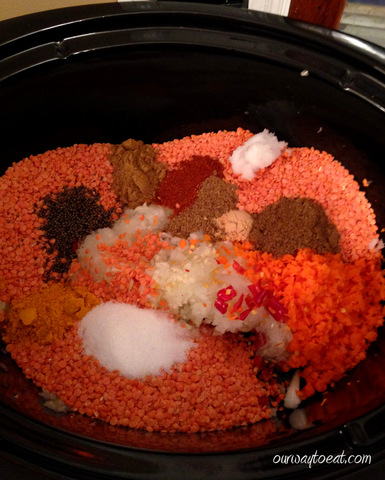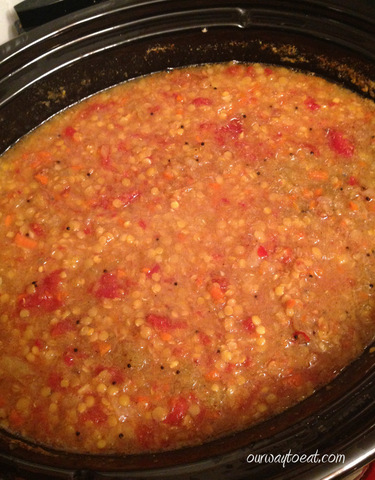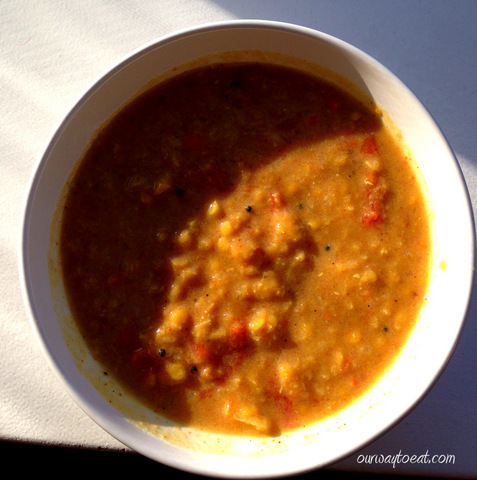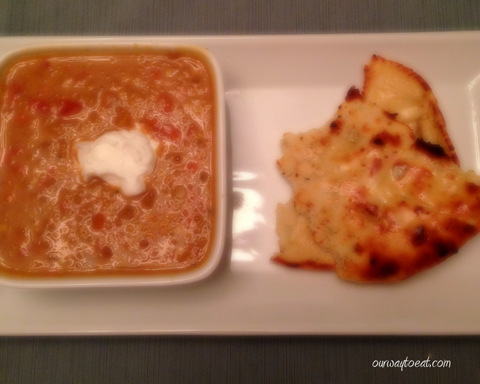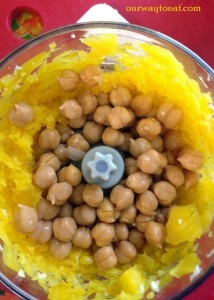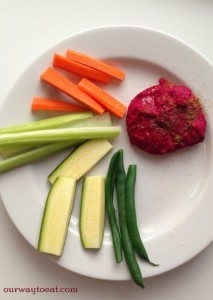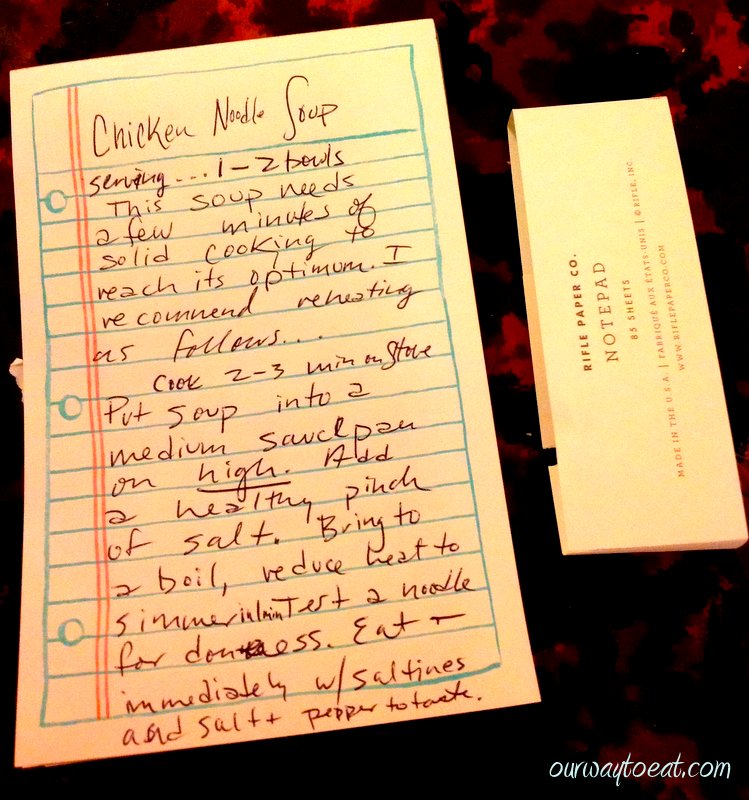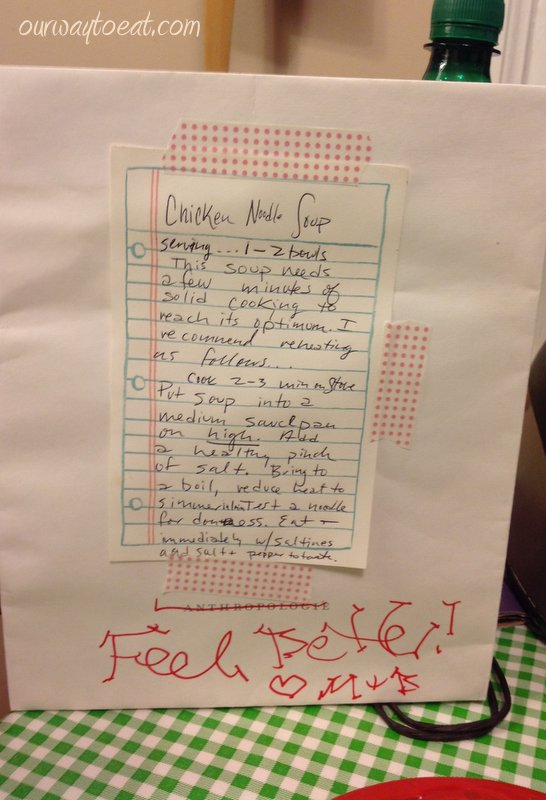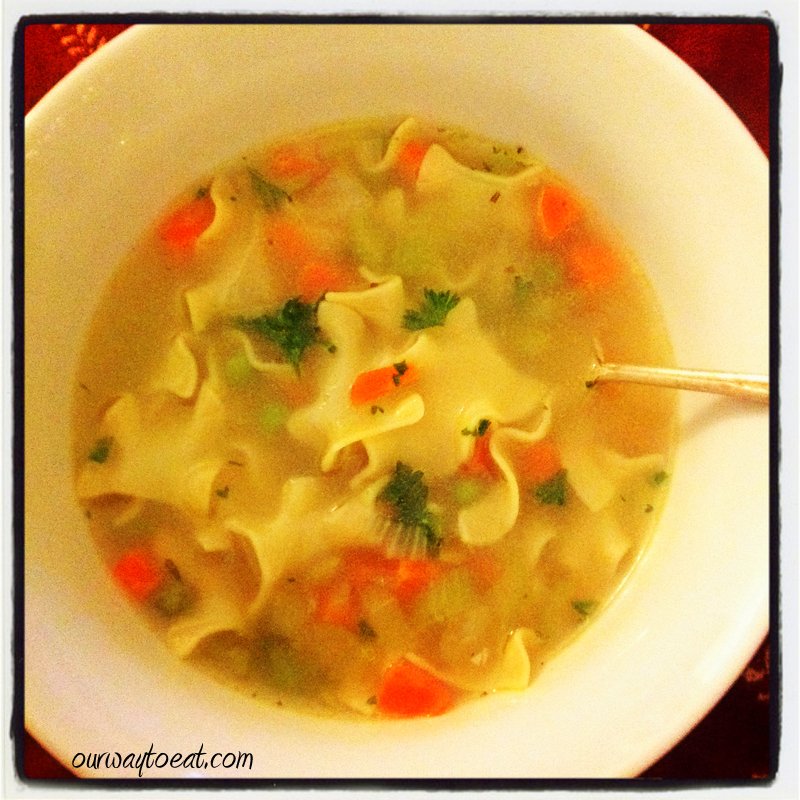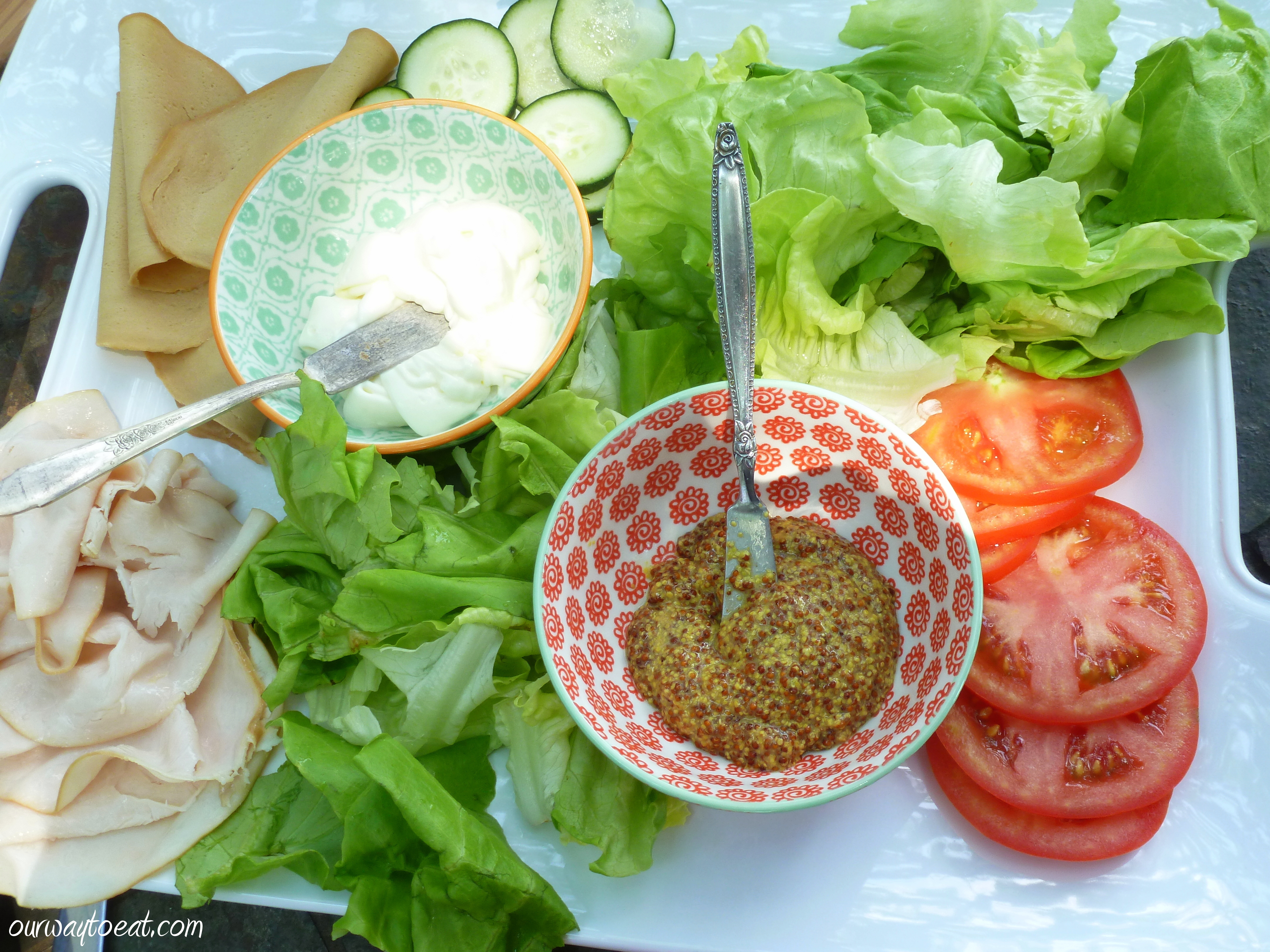 Crunchy local cukes and sliced onions in a potent bath of vinegar and water with salt and pepper is the perfect accompaniment to all summer food, as far as I am concerned. The flavor of the freshest mild-skinned early season cucumbers against a headstrong vinegary backdrop awakens the palate and provokes a deeply familiar taste of childhood that brings me right back to the dining room table at my Grandma’s farmhouse. My only addition to this simple recipe-less side from my past is a fluttering electric frizz of fresh dill just picked from the garden and snipped on top. Added sensory bonus: if you bring the leftovers to work and the container opens in your bag, you can smell/smell like the summery parfum of vinegar, onions and dill all day long!
Crunchy local cukes and sliced onions in a potent bath of vinegar and water with salt and pepper is the perfect accompaniment to all summer food, as far as I am concerned. The flavor of the freshest mild-skinned early season cucumbers against a headstrong vinegary backdrop awakens the palate and provokes a deeply familiar taste of childhood that brings me right back to the dining room table at my Grandma’s farmhouse. My only addition to this simple recipe-less side from my past is a fluttering electric frizz of fresh dill just picked from the garden and snipped on top. Added sensory bonus: if you bring the leftovers to work and the container opens in your bag, you can smell/smell like the summery parfum of vinegar, onions and dill all day long!
Category Archives: Healthy
Red Lentil Dal / Masoor Dal in the Crock Pot or Slow Cooker
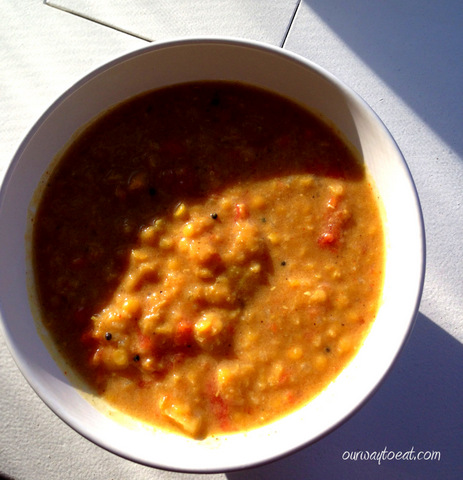 There is something wonderfully comforting about coming home to a warm meal ready to eat without any effort, even if you did in fact make it yourself. No matter what kind of day you had, you can right the wagon when you come home to a crock pot simmering with this warming soup. The spicy aroma seeps out of the cracks of your house, and gives you a warm and welcoming hug before you even walk in the door. I like to put together a crockpot meal the night before the day in my week that most needs fixing. For me, that is Monday. I come home, fling open the door and say “honey, I’m home” and then singsong back to myself in reply, “supper’s ready!” This is a healthy, low fat, plant strong meal. It qualifies for all sorts of healthy eating buzz words: vegetarian, Meatless Monday, vegan, slow carb, plant strong and nutritarian.
There is something wonderfully comforting about coming home to a warm meal ready to eat without any effort, even if you did in fact make it yourself. No matter what kind of day you had, you can right the wagon when you come home to a crock pot simmering with this warming soup. The spicy aroma seeps out of the cracks of your house, and gives you a warm and welcoming hug before you even walk in the door. I like to put together a crockpot meal the night before the day in my week that most needs fixing. For me, that is Monday. I come home, fling open the door and say “honey, I’m home” and then singsong back to myself in reply, “supper’s ready!” This is a healthy, low fat, plant strong meal. It qualifies for all sorts of healthy eating buzz words: vegetarian, Meatless Monday, vegan, slow carb, plant strong and nutritarian.
Ingredients:
- 3 cups of red lentils, inspected on a white plate or platter, debris removed.
- 8 cups of water—really, it’s a soup that does not at all require stock!
- 1 onion, finely chopped.
- 2-3 carrots, grated.
- 1 cup of tomatoes, canned or fresh, chopped.
- 2 cloves of garlic, minced.
- 2 Thai chilies, minced. I used dried Thai Dragon chilies from my garden. Something similar is easily available at the grocery store.
- 1 teaspoon cayenne pepper
- 1 teaspoon ground cumin
- 1 teaspoon ground coriander
- 1 teaspoon ground turmeric
- 2 teaspoons Garam Masala
- 1 teaspoon ground ginger, or ¼ cup grated fresh ginger
- 1 tablespoon sea salt
- 1 teaspoon black mustard seeds, toasted in a pan on the stove until popping
Optional additions – 1-14 ounce can of coconut milk –totally optional, gives the soup some creamy body, and the spices a place to hang since there is no other added fat included but the soup is lower fat and still wonderfully flavorful without it.
Method:
Inspect lentils, chop onion, garlic, fresh ginger (if using) and Thai Chilies and add to liner of your crock pot. Toast mustard seeds and add them along with all other seasonings to the liner of your crock. When you are ready to start the crock, add 8 cups of water and tomatoes. Stir, and cook on low for 6 hours, then stir in coconut milk, if using, and return Dal to a simmer. If you are a Midwesterner, exclaim as Bjorn jokingly did, “its good, Dal garnit!”
Serve warm with Greek yogurt or sour cream to garnish, and warm Naan or Basmati rice on the side.
Vibrant Beet Hummus
My red beet hummus and veggie plate is a stunner, if you ask me. This is how it came to be, and how to make it.
 A few weeks ago, we ventured out to the Minneapolis Institute of Art. After seeing a few exhibits, we developed a hunger and a thirst. All we wanted was something small, to tide us over to dinner.
A few weeks ago, we ventured out to the Minneapolis Institute of Art. After seeing a few exhibits, we developed a hunger and a thirst. All we wanted was something small, to tide us over to dinner. 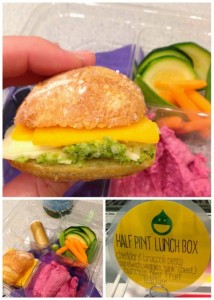 We ended up sharing the neat little bento box you see above that we bought at Half Pints, a new snack counter aimed at the Institute’s younger crowd. The “Lunch Box” we selected contained a cute little cheese sandwich with broccoli pesto, pear fruit leather and creamy “pink” beet hummus with veggies. We aren’t the 5 year olds this lunch was designed for, but we might as well be, because we thought it was the perfect healthy and satisfying snack along with a big bottle of mineral water.
We ended up sharing the neat little bento box you see above that we bought at Half Pints, a new snack counter aimed at the Institute’s younger crowd. The “Lunch Box” we selected contained a cute little cheese sandwich with broccoli pesto, pear fruit leather and creamy “pink” beet hummus with veggies. We aren’t the 5 year olds this lunch was designed for, but we might as well be, because we thought it was the perfect healthy and satisfying snack along with a big bottle of mineral water.  I often make hummus for us to pack up for lunches and snacks at work. We’ve been around the block with regular chickpea hummus, extra garlicky, white bean and purchased roasted red pepper varieties. Discovering beet hummus gave me the inspiration to add some much-needed variety, vibrant color and a unique flavor to our hummus. The result was gorgeous and is just what we need to provide the brightness and potent superfood fuel we need to help us down the last dregs of winter.
I often make hummus for us to pack up for lunches and snacks at work. We’ve been around the block with regular chickpea hummus, extra garlicky, white bean and purchased roasted red pepper varieties. Discovering beet hummus gave me the inspiration to add some much-needed variety, vibrant color and a unique flavor to our hummus. The result was gorgeous and is just what we need to provide the brightness and potent superfood fuel we need to help us down the last dregs of winter.
Ingredients:
- 1 medium or large red or golden beet, scrubbed clean, boiled or roasted, peeled, and cut into chunks. Cook’s note: the brilliant color and slightly stronger flavor of red beet is the boldest, while the golden beet’s color turns out slightly subdued when ingredients are combined and the flavor is also more subtle, unless you double the lemon and garlic, like I did–it was zesty!
- 1 to 2 tablespoons tahini sesame seed paste (optional)
- Juice and zest of 1/2 to 1 lemon
- 1 clove of garlic, minced fine
- 1.5 teaspoons ground cumin
- 1 14 ounce can of chickpeas or cannelini beans, rinsed (or dry beans that you’ve picked through and soaked overnight.) When I use chickpeas, I remove their skins so that the hummus will be extra smooth.
- A little water
- Fresh ground pepper and salt
- Optional garnishes: olive oil, cumin or paprika.
Boil or roast and peel the beet, cut it into chunks that will fit in your food processor (I use a Ninja). Pulse beet in processor until smooth, add beans, lemon zest, garlic and cumin and process.
Add tahini (if using) and lemon juice sparingly, one-half teaspoon at a time, pulse hummus until smooth and creamy. Add additional lemon juice or a little water as needed to make the hummus the creaminess you desire. It is best not to go overboard with lemon juice, as the flavor can overpower the beet. Adjust flavor with salt and pepper. Serve with crudites, wedges of pita or crackers. If serving at a party, drizzle with olive oil, and garnish with a pinch of cumin or paprika.
Chicken Noodle Soup – A Cure for Cold Season
When the long Minnesota winter is starting to wear on us, there are certain classic recipes that we revisit every year. A bowl of homemade soup provides a fortifying boost of energy and straightforward, clean flavors that help a body endure the waning months of cold and darkness.
A steaming bowl of chicken or chicken-less noodle soup is a warming cure for winter blahs if I know one. It is so comforting if you have a cold. I don’t follow an exact recipe to make Chicken and Chicken-less Noodle soup. I chop a few peeled carrots, a few ribs of celery and onion, and saute them in a little oil until fragrant, but still crisp. Then, I add about 5 cups of broth, (homemade when I have it). I bring the soup to a point beyond a simmer and add two handfuls of frozen peas. When the soup returns to almost-boiling I add a few handfuls of egg noodles, and about a quarter cup of chopped fresh parsley. I like to use ample, wavy, dumpling egg noodles. They need 6-10 minutes of cooking time to cook to tender, but not soggy. 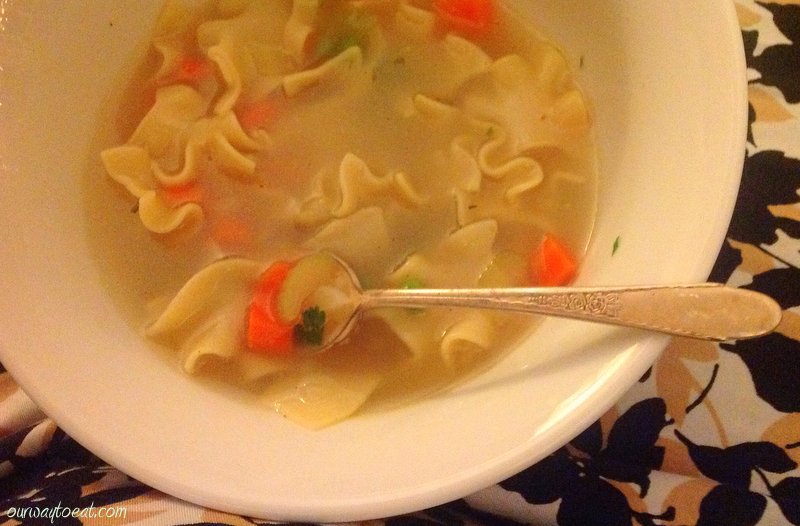 In order to make chicken-less soup for myself, and classic chicken noodle soup for Bjorn, I saute chicken breasts or thighs separately. When the chicken is cooked through, I chop it and add a hearty serving of chopped chicken to his bowl. You can make a whole pot of chicken-less soup if everyone prefers, or you can saute the chicken along with the veggies if everyone at your house eats chicken. Before serving, I adjust the flavour with salt and pepper. If you are a stickler for following a recipe, Martha Stewart’s Chicken Noodle Soup is similar to my general guidelines, except that she doesn’t add peas; she opts for dill instead of parsley and she uses quick-cooking vermicelli noodles instead of wide egg noodles. This soup is flexible. You could add other veggies. For me, I like to stick to the classic Chicken Noodle soup ingredients, except that I leave out the meat.
In order to make chicken-less soup for myself, and classic chicken noodle soup for Bjorn, I saute chicken breasts or thighs separately. When the chicken is cooked through, I chop it and add a hearty serving of chopped chicken to his bowl. You can make a whole pot of chicken-less soup if everyone prefers, or you can saute the chicken along with the veggies if everyone at your house eats chicken. Before serving, I adjust the flavour with salt and pepper. If you are a stickler for following a recipe, Martha Stewart’s Chicken Noodle Soup is similar to my general guidelines, except that she doesn’t add peas; she opts for dill instead of parsley and she uses quick-cooking vermicelli noodles instead of wide egg noodles. This soup is flexible. You could add other veggies. For me, I like to stick to the classic Chicken Noodle soup ingredients, except that I leave out the meat.
A little while ago, Bjorn’s brother was under the weather, so we decided to bring him a serving of our soup. I removed a portion of the soup and put it in a disposable container before the noodles were fully cooked so that he could bring the soup up to temp without the noodles getting soggy.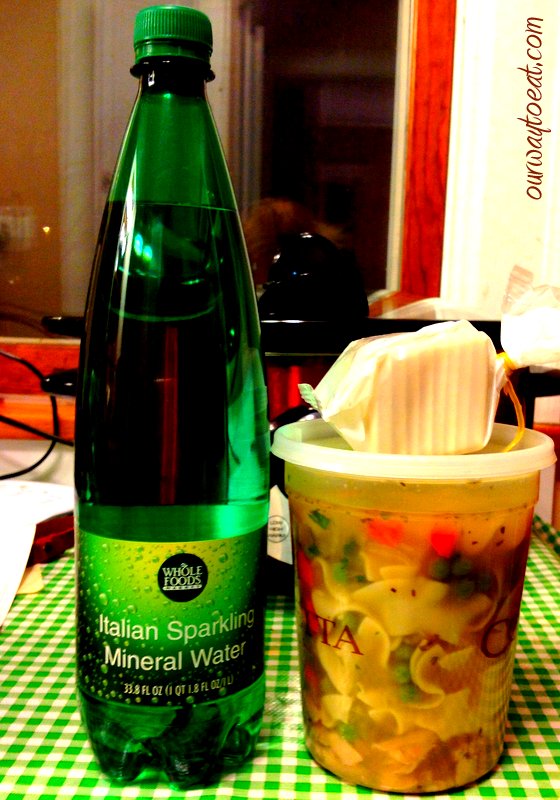
To round out our care package, we added a bottle of fizzy mineral water for some electrolytes and a quarter-sleeve of saltines to go along with the soup.
I taped my handwritten instructions to a small bag with washi tape and we dropped the package off at Brett’s house, hoping to bring a little warmth and cheer to a dreary sick day. Homemade soup tastes wonderful and fills the house with a comforting aroma. This soup is made entirely of staples that are usually on hand in the pantry and freezer. Chicken Noodle soup cooks quickly and provides comfort, flavor and textures you just can’t get from a can. When you’ve had it with winter, remember to make this soup!
Inspiration for Winter Salad Season
 You might think a person’s natural “Salad Season” would occur in the summer. Since I started photo-documenting the food we eat, I have discovered our true salad season occurs in the deep winter. We certainly don’t have a dazzling array of garden and local produce available, but even so, we do our best to choose the best produce and canned goods available to get by. This is probably the season when we need hearty salads the most here in the Midwest. Our bodies are hiding in bundles of clothing, we spend our time mostly indoors and in natural darkness, and we inevitably encounter a number of virus threats on a weekly basis. I consider these light, bright, crunchy, energizing, nutrient rich, colorful salads, [along with sleep] to be one of the secrets to a maintaining a pretty reliable immune system. They are also my January-February hope that when spring arrives, I will feel and look more springy than a person feels in the depths of winter.
You might think a person’s natural “Salad Season” would occur in the summer. Since I started photo-documenting the food we eat, I have discovered our true salad season occurs in the deep winter. We certainly don’t have a dazzling array of garden and local produce available, but even so, we do our best to choose the best produce and canned goods available to get by. This is probably the season when we need hearty salads the most here in the Midwest. Our bodies are hiding in bundles of clothing, we spend our time mostly indoors and in natural darkness, and we inevitably encounter a number of virus threats on a weekly basis. I consider these light, bright, crunchy, energizing, nutrient rich, colorful salads, [along with sleep] to be one of the secrets to a maintaining a pretty reliable immune system. They are also my January-February hope that when spring arrives, I will feel and look more springy than a person feels in the depths of winter. 
Our first salad, shaved carrot, Parmesan, radish, white bean and raw sunflower seeds on romaine. 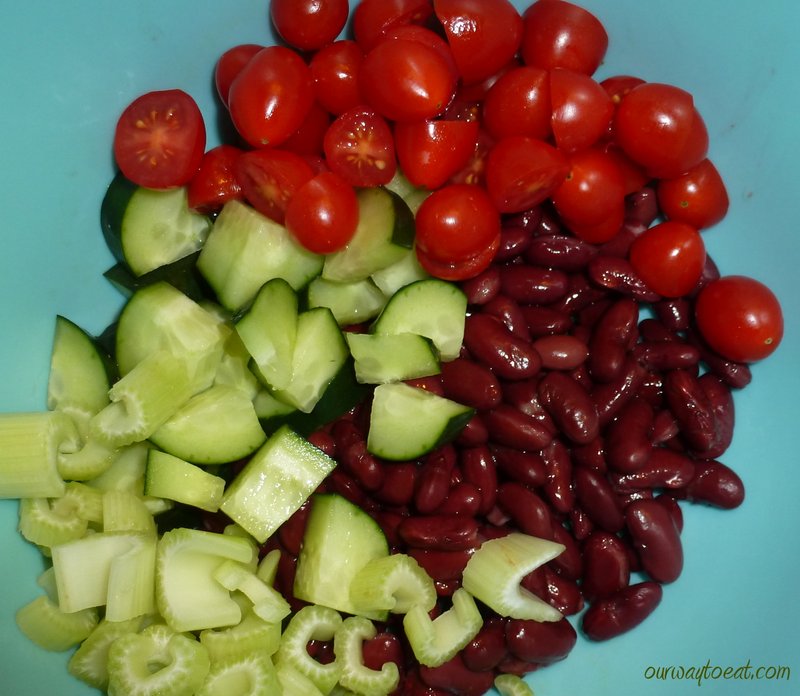 I start preparing our salads by adding its prominent components to a bowl. Chop something crunchy (celery), add a protein (kidney beans), add any other vegetables you have on hand and wish to include (here, cukes and halved grape tomatoes) , toss with greens, (here, romaine and spinach). If you care to, add a flavor/texture “treat” such as seeds, nuts, avocado, egg or a bit of cheese. This is the way to make a great winter a great salad.
I start preparing our salads by adding its prominent components to a bowl. Chop something crunchy (celery), add a protein (kidney beans), add any other vegetables you have on hand and wish to include (here, cukes and halved grape tomatoes) , toss with greens, (here, romaine and spinach). If you care to, add a flavor/texture “treat” such as seeds, nuts, avocado, egg or a bit of cheese. This is the way to make a great winter a great salad. I typically toss greens with either some citrus juice, lime, lemon, orange or grapefruit or a flavored vinegar. My favorite vinegars are red wine, balsamic or tarragon vinegar. Then I drizzle just a few drops of olive oil and toss the greens. It is surprising how little oil you need to bring all of the flavors together. Sometimes I add a tablespoon or two of Dijon mustard, or a teaspoon of honey or jam to the oil and vinegar/citrus mixture before mixing vigorously to add further flavor and help the dressing to emulsify before tossing the liquids with the greens. Chopped fresh herbs or dried herbs along with salt and pepper added according to taste complete the dressing.
I typically toss greens with either some citrus juice, lime, lemon, orange or grapefruit or a flavored vinegar. My favorite vinegars are red wine, balsamic or tarragon vinegar. Then I drizzle just a few drops of olive oil and toss the greens. It is surprising how little oil you need to bring all of the flavors together. Sometimes I add a tablespoon or two of Dijon mustard, or a teaspoon of honey or jam to the oil and vinegar/citrus mixture before mixing vigorously to add further flavor and help the dressing to emulsify before tossing the liquids with the greens. Chopped fresh herbs or dried herbs along with salt and pepper added according to taste complete the dressing. 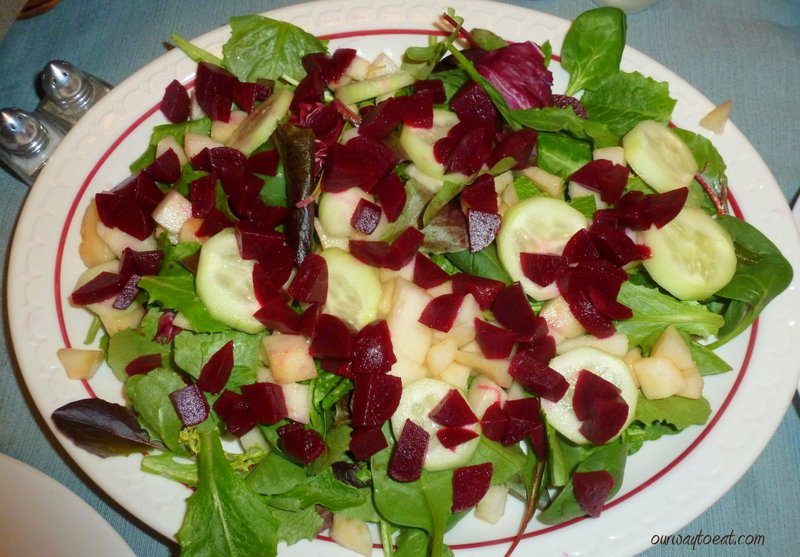 This salad is composed of beets, peeled bosc pear and sliced cucumber on mixed greens dressed with leftover grapefruit juice and fresh thyme dressing and a little pepper and salt. Don’t hesitate to open a can of beans, beets or citrus canned (hopefully BPA free) in its natural juice. There are many health benefits and few sacrifices when you add these nutrient-rich ingredients the easy way.
This salad is composed of beets, peeled bosc pear and sliced cucumber on mixed greens dressed with leftover grapefruit juice and fresh thyme dressing and a little pepper and salt. Don’t hesitate to open a can of beans, beets or citrus canned (hopefully BPA free) in its natural juice. There are many health benefits and few sacrifices when you add these nutrient-rich ingredients the easy way. 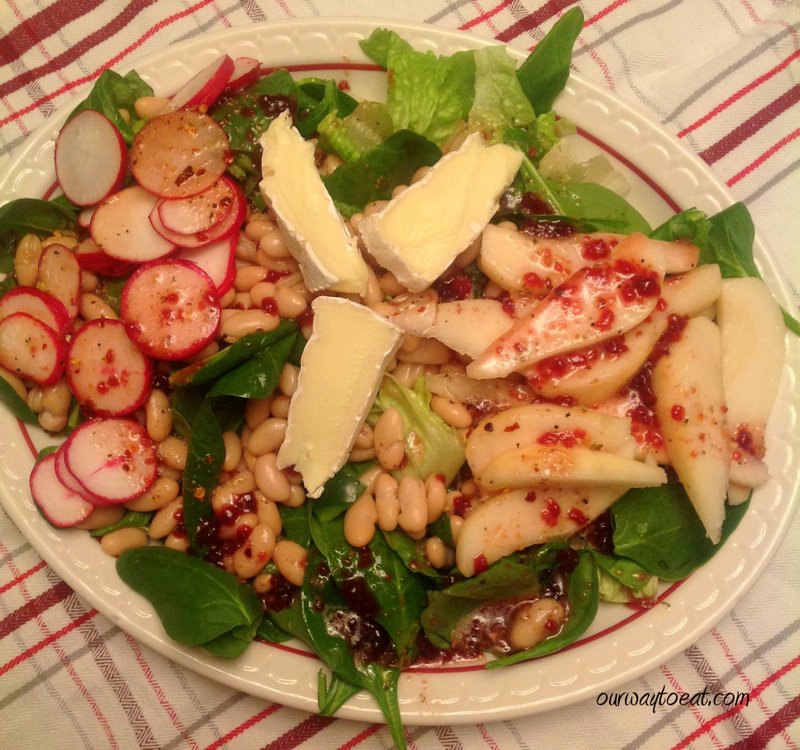
The next salad is composed of sliced radish, sliced pear, white beans and a few slices of brie on spinach with citrus-preserve dressing. 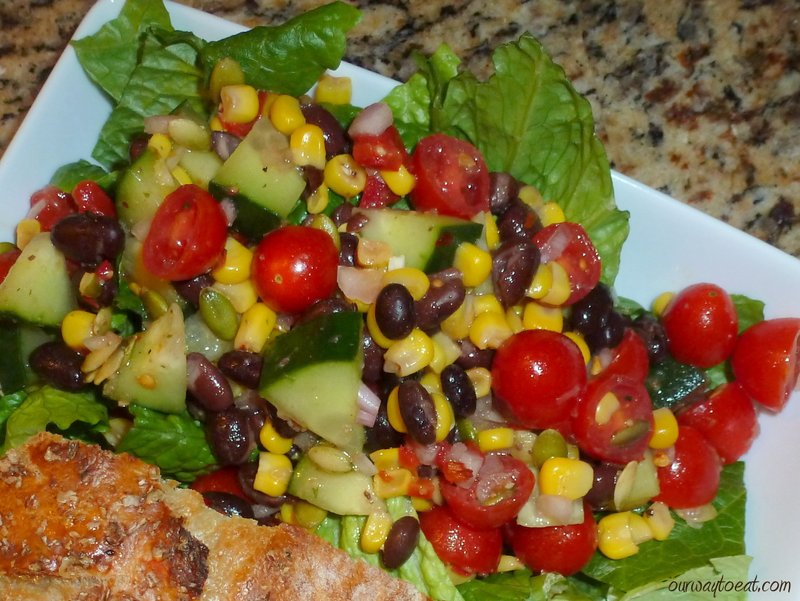
Another great salad is composed of corn, black beans, peeled and quartered cukes, minced scallion, halved grape tomatoes and pepitas dressed with lime juice, olive oil, honey and chili flakes over romaine. 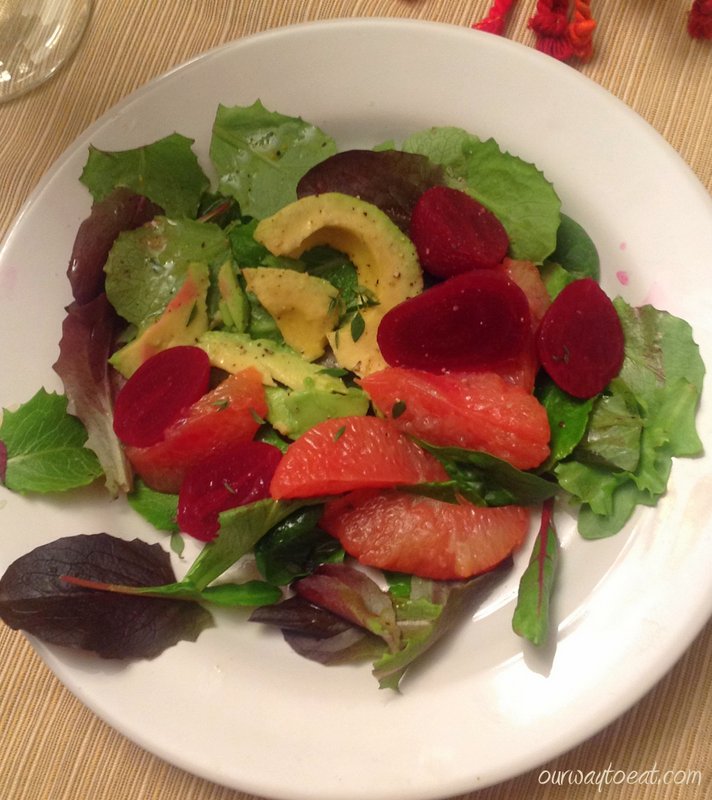 In my book, this winter salad is special, grapefruit supremes, sliced avocado and red beets on mixed greens with grapefruit juice and olive oil dressing with thyme leaves.
In my book, this winter salad is special, grapefruit supremes, sliced avocado and red beets on mixed greens with grapefruit juice and olive oil dressing with thyme leaves.  Here is another hearty and satisfying salad we’ve enjoyed composed of shaved carrot, celery, chickpeas, sliced radish and provolone on romaine-spinach mix.
Here is another hearty and satisfying salad we’ve enjoyed composed of shaved carrot, celery, chickpeas, sliced radish and provolone on romaine-spinach mix.
Salads in winter are limited by the produce in season, but those limitations can open up room for creativity. Salads like these complete a meal as a healthy side dish or stand as a meal on their own. Certainly, they brighten your plate and the winter— try ’em.
Cucumber Days
Take two, I had a few issues with my first post made from my Ipad, so I’ll try that again… 3 years into gardening, this is the first year we’ve had any success with cucumbers. This year, we are enjoying them regularly in salads, on tacos and most commonly sliced thin, perhaps peeled, and tossed into a bowl with cracked pepper, sliced purple or white onions, snipped fresh herbs, such as chives, flat-leaf parsley, or dill all soaked in white vinegar and a splash of water. This is a taste from childhood that I learned to love at my Grandma’s house, fresh from her garden. We are harvesting spicy Serrano and hot, citrusy Lemon Drop peppers every day. I have been chopping these and tossing them into the vinegar-water mixture. It mellows their bite enough to make them a perfect, punchy but palatable addition to the mix. I consider this sliced cucumber, onion, hot pepper and herb mixture a perfect summer side dish, snack, condiment and salad.
There are two schools of thought on the ubiquitous sliced cucumber side dish, one vinegary, like mine, and the other, a creamy version made with sour cream. Check out this recipe for the creamy version of sliced cukes on Deucecities Henhouse, a favorite Twin Cities based blog haunt of mine.
Watching the cukes grow has been almost as much fun as eating them. Ours are growing in all sorts of unconventional shapes. I spend time every week tying tomato plants to chicken wire and winding twine around bamboo poles to support green beans, peppers and peas. Cucumber vines take the initiative of sending out tendrils that stretch out until they find other plants and structures nearby, then curling the tendrils tightly around so they hang tight. Cucumbers are fully capable of supporting themselves.
Garden Delights // Square Foot Garden // July Update
Our garden delights me! We find ways to eat fresh veggies and herbs in every meal. I keep learning and I enjoy everything except the squirrels!
The Summer Sandwich // Simple Dining, Al Fresco
 This post is one part ode to one of my favor summer meals and one part cautionary tale. I figure that this blog is about my life, including some of the great meals in it, so I will start with a brief account the day when I spent inadvertently spent $17.72 on 0.57 lbs of cheese. [Oopsie.]
This post is one part ode to one of my favor summer meals and one part cautionary tale. I figure that this blog is about my life, including some of the great meals in it, so I will start with a brief account the day when I spent inadvertently spent $17.72 on 0.57 lbs of cheese. [Oopsie.] 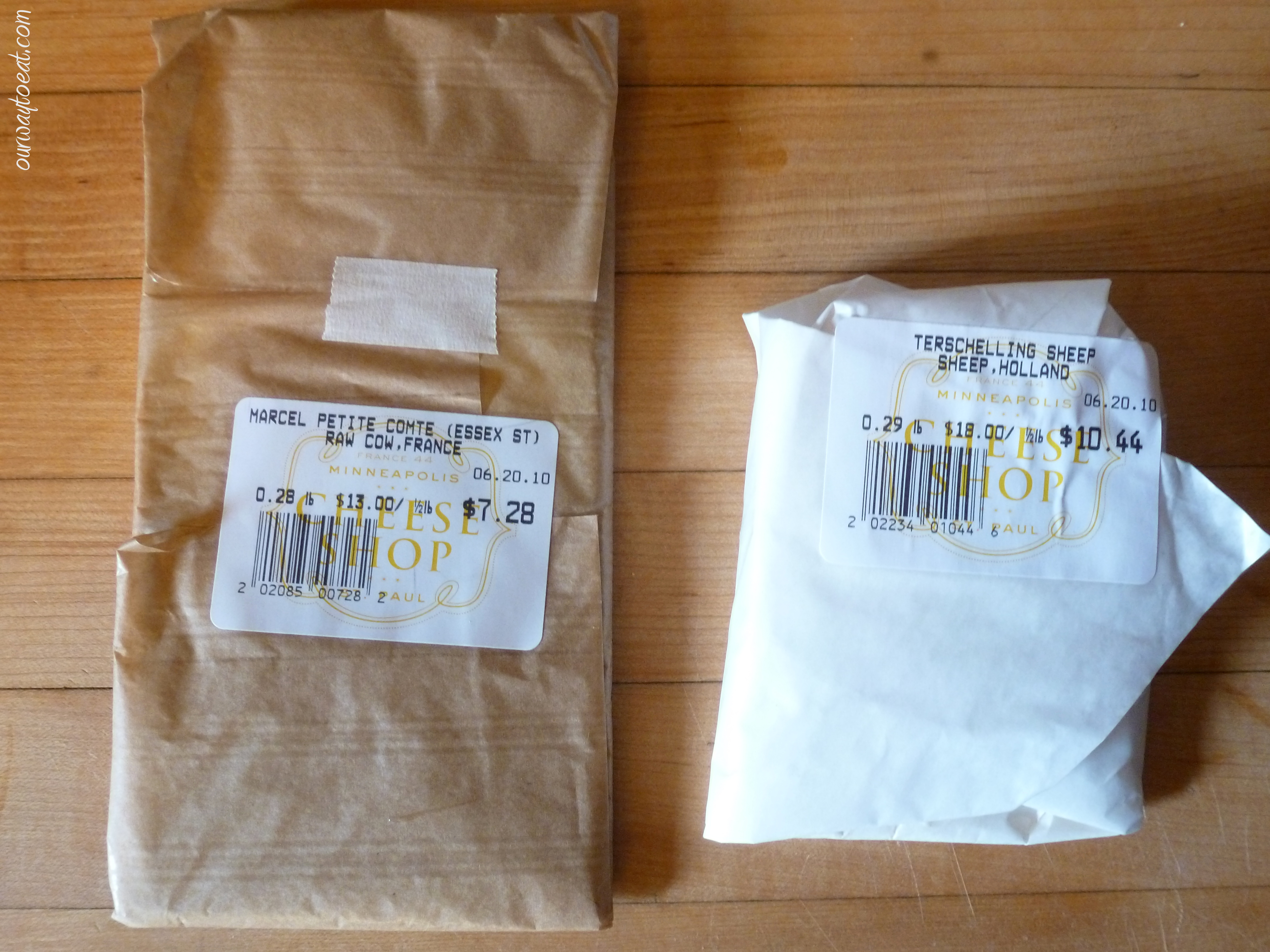
It was a typical Saturday morning. We started our day at the Saint Paul Farmer’s Market. I determined my mission that day was to purchase the components of a summer sandwich for our lunch. At the time, our garden still had a few weeks to go before it would have much to offer us. I bought vegetables, bread, and then we left the market and looped our way up Grand Avenue to the Saint Paul Cheese Shop. That place is pretty neat. Sampling is encouraged, so we tasted several paper-thin wisps of cheese the cheesemonger shaved neatly off of several wheels of cheese and dropped into our extended hands from the forked tip of the blade of his cheese knife. I let my guard down. It is atypical for me to make a mindless splurge without glancing at the price per half pound. I was in a cheese-induced stupor when I asked for a small wedge of Marcel Petite Comte raw cow’s milk cheese from France, and a wedge of Terchelling Sheep’s milk cheese from Holland. I’m sure there are people who routinely spend far more than this on cheese in any given week. I’m not knocking it and I might do it again at some point. The difference will be that I do it intentionally. As a consolation, at least the cheese was very, very good.
Whew. Now that I’ve made that confession to my friends and readers, let’s make a sandwich! A Summer Sandwich is quite simply a sandwich with any combination of meat or vegetarian meat substitute, seasonal vegetables, cheese and sandwich spreads piled on top of nice bread. 
I sliced a grainy loaf of bread and served the bread and cheese with our own cheese knives on wooden cutting boards. We eat most of our meals al fresco on our patio. It has been 90+ degrees farenheit there lately, but it is still very pleasant in the shade of a Maple Tree canopy.
I filled a platter with sliced cucumber and tomato, garden lettuces, piles of deli turkey and tofurky, along with bowls of mayonnaise and grainy dijon mustard, and placed salt and pepper shakers on the table. The secret to the perfect summer sandwich is bringing out whatever looks good and fresh, and let each person assemble the sandwich they desire. 
If Freud were here, he’d say, “a sandwich is never just a sandwich.” It is the meal I ate on pebble beaches out of a cooler with my parents camping in Door County, Wisconsin in grade four. It is the BLT’s that beckoned numerous cousins, Uncles and Aunts to my Grandma’s farm house every July when the tomatoes were all ripe at once. It is the meal of lettuce, ham, turkey, tomato and cheese sandwiches on good sandwich bread that we shared with friends from Edmonton, Winnipeg, Saint Paul and Minneapolis on a lakeshore in Northern Minnesota after a long, hot day on the lake last year over the 4th of July long weekend. It is the halved baguettes piled with cheese, sliced tomato and a pile of pršut [for the meat eaters] that we ate on a secluded pebble beach a few months ago in Croatia. 
What is one to serve on the side? Well, nothing—any decent summer sandwich is in itself, a square meal. Or, if the mood strikes, some salty-crunchy potato chips, leftover potato salad out of the fridge, deviled eggs or summer fruit would all be the perfect compliment. On this particular day we rounded out our plates with bright, rainbow radishes that were too pretty to slice or even to remove the stem. Sure, they could have been thinly sliced and piled on the sandwich, but they were refreshing, spicy perfection and a visual treat perched on the side our plates. 
A Summer Sandwich is simple perfection. No matter what fresh fixings are available, where you are, or what time it is, a sandwich satisfies hunger. A sandwich feeds a crowd with varied tastes, comes together easily and is a perfect meal to eat outdoors on a hot July day. 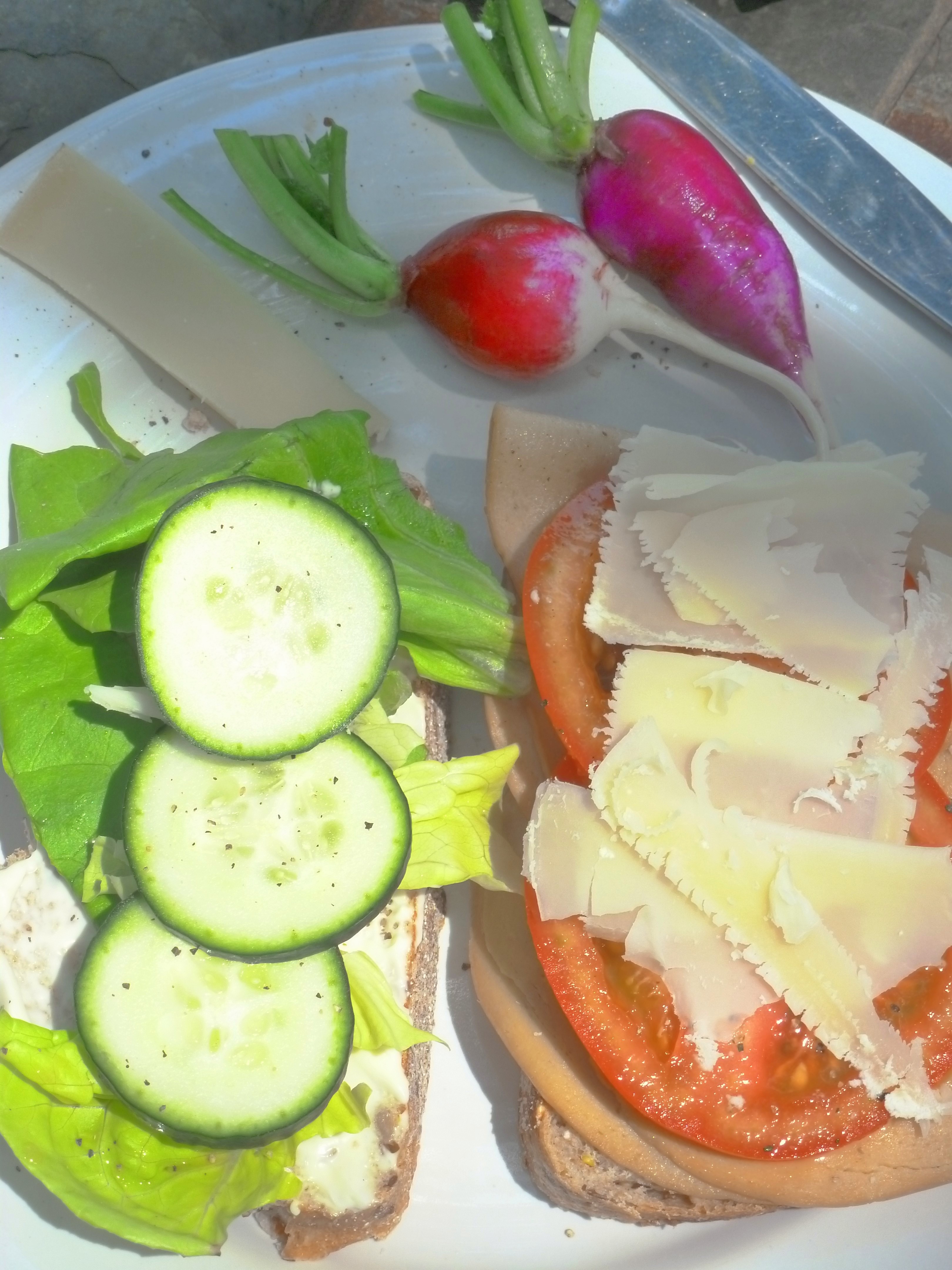
And the cheese?
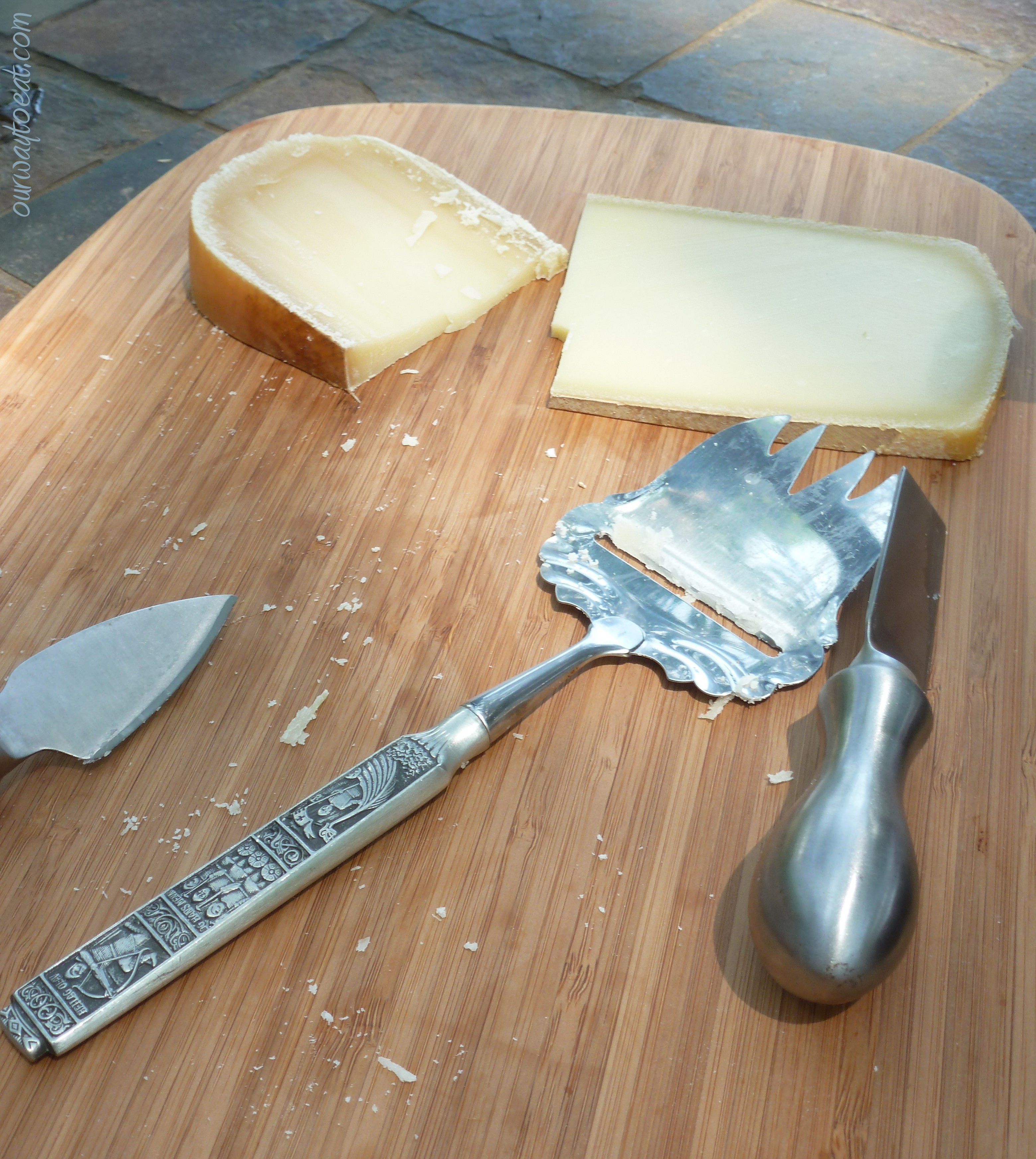 We’re still working our way through it, and savoring every little morsel–we figure it cost us about 8 cents per crumb.
We’re still working our way through it, and savoring every little morsel–we figure it cost us about 8 cents per crumb.
Happy Friday!
I find it somewhat ironic or at least interesting as a person who spends plenty of time thinking about, preparing and writing about our weekend and evening meals that Bjorn and I eat about 10 meals every week away from home. We eat these meals in our cars, at our desks in our respective offices or in an empty conference room with co-workers. We don’t eat shabbily. I make an effort to make even the food I pack for our breakfasts and lunches something to enjoy, while being easy to prepare, healthy and portable.
The fact that we spend a lot of time at work is a fact of life. It is also a fact that I don’t like to think of the alternative of not having stable careers. I snapped these pictures of my simple breakfast of avocado mashed on top of a reheated slice of garlic bread that I ate at my desk this morning. This was a TGIF moment. As much as I appreciate my job, I love heading home in the bright sunshine with the weekend ahead. Enjoy!
Scrambled Eggs with Chives, Cucumber and Tomato Salad
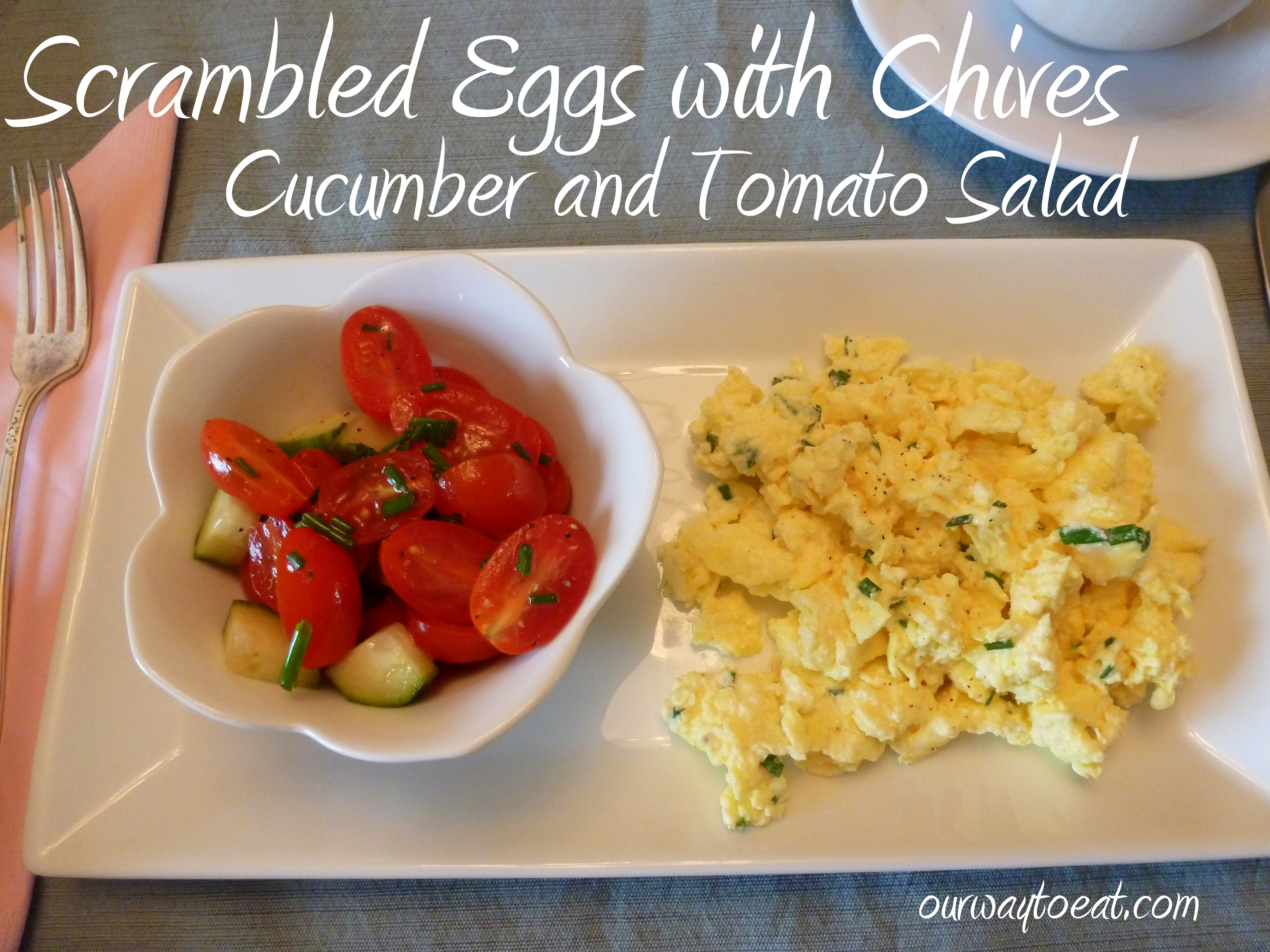 This is one of my favorite moments in the spring. We have a tree in our front yard that has burst into bloom and covers our yard in an a canopy of electric-pink blossoms. When the wind blows, soft petals drift through the air and settle into the grass like fuchsia confetti. I try not to stray far from home while this tree is in bloom, lest I miss a precious moment of our tree’s bold and reverent announcement of spring’s arrival.
This is one of my favorite moments in the spring. We have a tree in our front yard that has burst into bloom and covers our yard in an a canopy of electric-pink blossoms. When the wind blows, soft petals drift through the air and settle into the grass like fuchsia confetti. I try not to stray far from home while this tree is in bloom, lest I miss a precious moment of our tree’s bold and reverent announcement of spring’s arrival.

In the back yard there isn’t a whole lot going on yet. Most of our 96 square feet of raised beds are looking forlorn and neglected. Even so, dandelions are anxiously popping up in the lawn and there are a few random leaves of lettuce and herbs that managed to re-seed themselves poking their way up in our raised beds. The exceptions are the 2 square feet which are abundantly producing our earliest perennial crop — Chives! 
I swear that the first moment the sun comes out in the spring, these little troopers start growing like mad. They don’t give a rip about snow and frost. I love these dark coloured, mild-flavoured little toughies. I transplanted mine from my parents’ garden. My Mom and Dad tend an amazing flower garden in their partially wooded, partially sun-soaked yard on a lake in rural Northern Minnesota. They focus on flora and their only edibles are chives, rhubarb and my Dad’s small blueberry patch. They have always grown chives and my Mom sends me out to snip a small bunch to garnish baked potatoes and other dishes when I’m home. I love chives on potatoes, salads, and pasta and pretty much anything that can be heightened by the addition of a dark green garnish with a mild, onion-y flavour. 
Our garden’s earliest offering provided me with the jumping-off point for our breakfast. I did a quick Google search to see what others have been saying about chives at breakfast time. I quickly found two breakfasts with chives in a starring role. The first was a recipe for Chive Scrambled Eggs by Martha Stewart. I don’t dig the thought of cottage cheese in scrambled eggs* so instead, I decided to follow inspiration and guidance in a recent post on a lovin’ forkful for our breakfast of scrambled eggs with chives and a grape tomato salad with a few tweaks of my own. 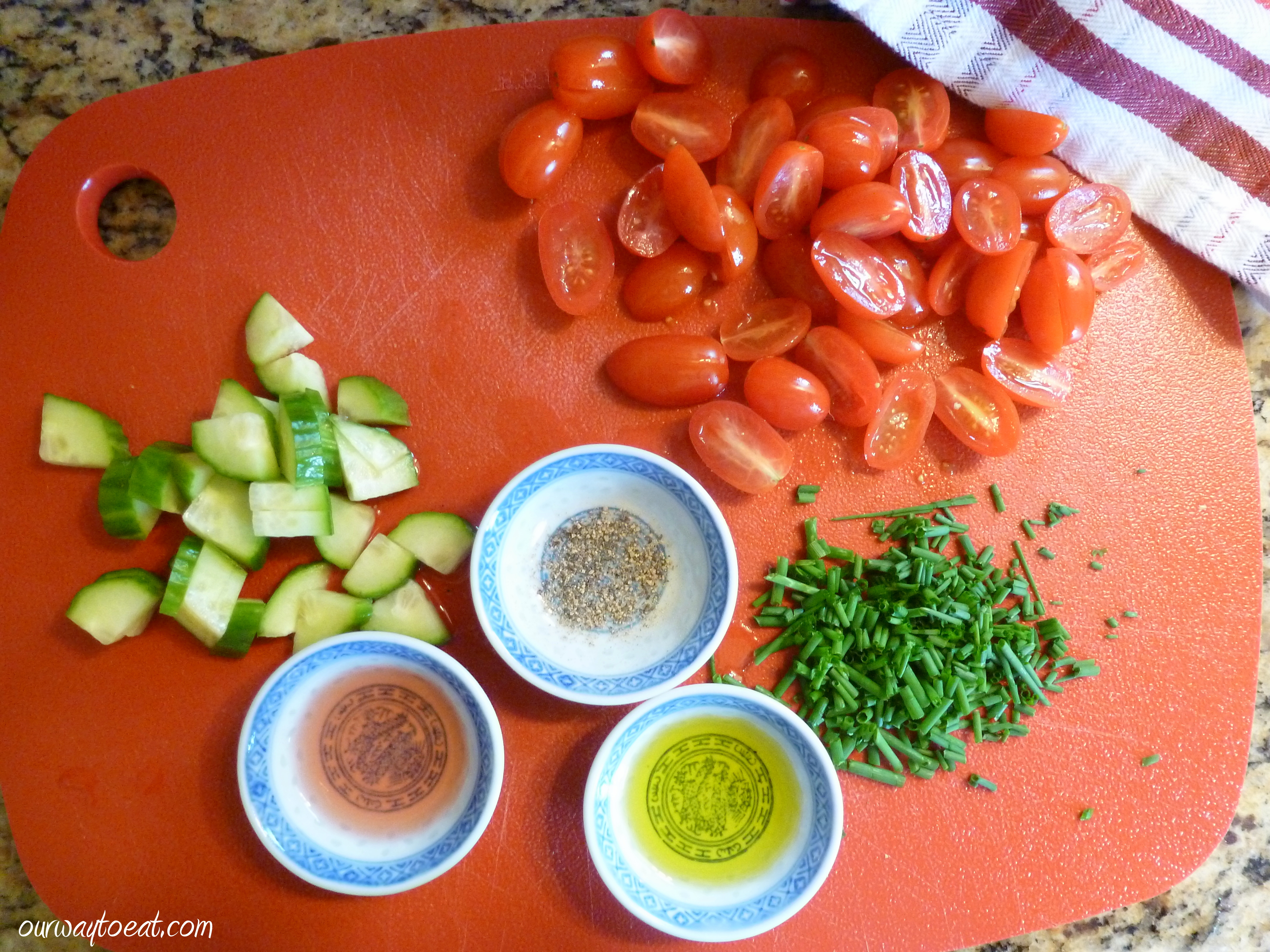
Tomato and Cucumber Salad, serves 2
- 1 cup grape tomatoes, sliced in half lengthwise
- 4 inches of cucumber, quartered and chopped
- 1 ½ Tablespoons Red Wine Vinegar
- 1 ½ Tablespoons Extra Virgin Olive Oil
- 1 ½ Tablespoons of fresh chives, rinsed and chopped
- Fresh Ground Black Pepper
To begin, I went outside with my kitchen scissors and snipped a small bunch of chives from each of my two abundant bunches. There will be no shortage of chives for us this summer, but I still try to use each bunch equally.
- 2 Whole eggs, plus 4 egg whites, lightly beaten
- 3 ½ Tablespoons light cream cheese
- 2 ½ Tablespoons fresh chives, rinsed and chopped
- ½ Tablespoon unsalted butter
Once the salad was assembled, I cracked the eggs 2 whole eggs into a bowl, then separated 4 more eggs, and added only the whites. I measured the cream cheese into the bowl, and ground black pepper into the eggs. Most recipes call for salt at this point but if you add salt as much as recipes and food shows call for, you are going to consume way too much salt. There is no need to exceed healthy sodium levels in your diet. There are so many other flavors and textures going on in most meals that you don’t need to salt your food at every turn for it to taste wonderful. Once the eggs were adequately whisked, I melted the butter in a non-stick pan and scrambled the eggs.
When the eggs were just set, I sprinkled chives and folded them in while the eggs finished cooking. I like my eggs on the done side. I’m all for super-soft eggs that are made so creamy and decadent at the Birchwood Cafe, but if I’m not there I prefer mine to be fairly firm. With the addition of cream cheese, the eggs stayed moist and turned out to be some of the fluffiest eggs I have ever made. As soon as the eggs were done to my liking, I served them in a low dish, and served the salad in small bowls on the side of our plates.
This breakfast hit the spot. It felt as springy as the day. The salad had light, refreshing flavors and the eggs were fluffy with a subtle creaminess. Our garden’s verdant chives carried a mild and pleasant onion-note throughout the plate. This breakfast was satisfying and gave us lightness and energy to enjoy the beautiful spring day before us, missing not one precious, perfumed breath.


